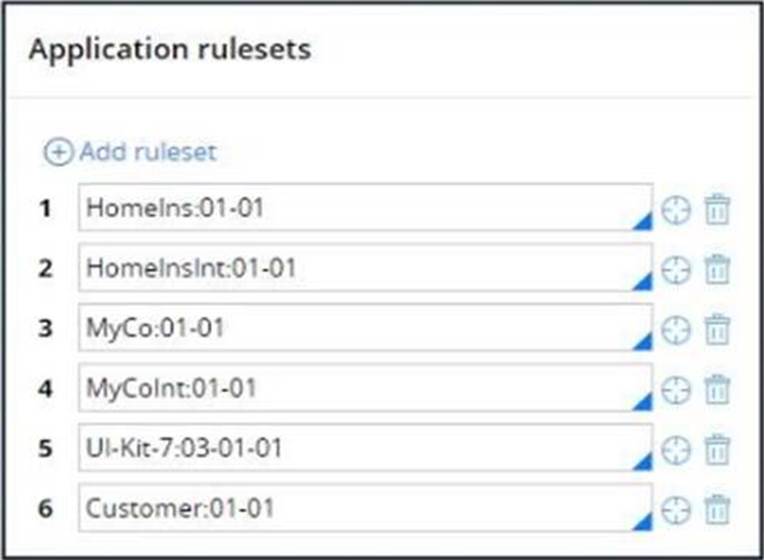Pegasystems PEGACSSA72V1 Certified Senior System Architect (CSSA) 72V1 Online Training
Pegasystems PEGACSSA72V1 Online Training
The questions for PEGACSSA72V1 were last updated at Dec 23,2025.
- Exam Code: PEGACSSA72V1
- Exam Name: Certified Senior System Architect (CSSA) 72V1
- Certification Provider: Pegasystems
- Latest update: Dec 23,2025
You are working on an update to an application which only affects some rules for a certain case type. The customer has requested that a patch update be released.
How do you create the new ruleset version?
- A . Use the Ruleset Maintenance wizard to merge the existing rules in the relevant rulesets to the new version.
- B . Create a branched ruleset, then copy the affected rules into the new branched ruleset.
- C . Use the Lock & Roll functionality to lock the current ruleset and increment the ruleset version.
- D . Use the Ruleset Maintenance wizard to skim the relevant rulesets to copy the highest version of existing rules to the new version.
In the following example, the HomeIns, HomeInsInt, and Customer rulesets are configured for application validation. MyCo and MyCoInt are configured for ruleset validation. MyCo lists MyCoInt and Customer as its prerequisites and the prerequisite for MyCoInt is Pega-ProcessCommander.

Which of the following statements is correct?
- A . Rules in MyCoInt can reference rules in Customer.
- B . Rules in MyCo can reference rules in HomeInsInt.
- C . Rules in Customer can reference rules in HomeIns.
- D . Rules in MyCo can reference rules in HomeIns.
Several development teams work on different enhancements. The release date for each enhancement is uncertain.
Which two options allow each team to keep its work separate? (Choose two.)
- A . Set up a branch ruleset for each team.
- B . Create a new application for each team.
- C . Create a new ruleset version for each team.
- D . Create a production ruleset for each team.
The ruleset list for an application consists of the following rulesets, ordered from highest to lowest:
– SelfService: 01-01
– TGB-HR:01-01
– TGB:01-01
A rule with an Apply to: class of TGB-HR-SelfService-Work-TimeOff references a rule named ConfirmRequest.
The four instances of ConfirmRequest in the rules cache are shown in the following table.

Which is chosen during rule resolution?
- A . TGB .ConfirmRequest (TGB:01-01-02)
- B . TGB-HR-SelfService-Work-TimeOff .ConfirmRequest (SelfService: 01-01-02)
- C . TGB-HR-SelfService-Work-TimeOff .ConfirmRequest (SelfService: 01-01-01)
- D . TGB-HR-SelfService-Work .ConfirmRequest (SelfService: 01-01-01)
An application has the following application rulesets:
– Expenses: 01-01
– TGB: 01-01
– TGBCatalog: 01-01
A rule with an Apply to: class of TGB-Expenses-Work-Reimbursement references a rule named PopulateLineItems.
The six instances of PopulateLineItems in the rules cache are shown in the following table.

Which rule is chosen by Rule Resolution?
- A . TGB-Expenses-Work.PopulateLineItems (TGBCatalog: 01-01-05)
- B . TGB-Expenses.PopulateLineItems (TGBCatalog: 01-01-05)
- C . TGB-Expenses-Work.PopulateLineItems (TGBCatalog: 01-01-03)
- D . TGB-Expenses-WorkPopulateLineItems (Expenses: 01-01-05)
- E . TGB-Expenses-Work.PopulateLineItems (Expenses: 01-01-03)
- F . TGB-Expenses.PopulateLineItems (Expenses: 01-01-03)
A user is processing a case and receives an error message that the system could not find an appropriate rule to use.
Select two possible reasons rule resolution failed to find a rule to execute. (Choose two.)
- A . The context of the rule chosen by rule resolution does not match the context of the referencing rule.
- B . The availability of the rule chosen by rule resolution is set to Blocked.
- C . The rule chosen by rule resolution is in a ruleset that is not in the application’s ruleset list.
- D . The user does not have appropriate privilege to access the rule chosen by rule resolution.
An application must support two case types. The case types are released into production on separate schedules.
Given these requirements, which specialization approach do you use?
- A . The case types are organized in the same class. Each case type is managed with a unique ruleset.
- B . All rules are managed in the same ruleset and circumstanced by case type.
- C . The case types are organized in unique classes. Each case type is managed with a unique ruleset.
- D . The case types are organized in unique classes. Both case types are managed with a single ruleset.
An application contains a flow action with an Apply to: class of TGB-HRApps-Work-TimeOff. When updating the application, you have a requirement to move the flow action to TGB-HRApps-Work so it can be used by more than one case type.
How do you prevent the application from using the rule in TGB-HRApps-Work-TimeOff?
- A . Set the availability of the flow action in TGB-HRApps-Work to “Final”.
- B . Set the availability of the flow action in TGB-HRApps-Work-TimeOff to “Not available”.
- C . Set the availability of the flow action in TGB-HRApps-Work-TimeOff to “Blocked”.
- D . Set the availability of the flow action in TGB-HRApps-Work-TimeOff to “Withdrawn”.
A company sends a standard confirmation email whenever a case is created.
In which layer of the Enterprise Class Structure (ECS) could you apply the email correspondence?
- A . Implementation
- B . Enterprise
- C . Unit
- D . Division
B
Explanation:
Reference: https://community1.pega.com/community/pega-academy/question/question-about-ecsenterprise-class-structure
You have a requirement to update account information in an external database. Account information is stored in a single table.
What are the two necessary steps to read and write data to the database table? (Choose two.)
- A . Configure activities to read and write data using Obj-methods.
- B . Configure a data page to use SQL connect rules.
- C . Run the External Database Table Class Mapping wizard.
- D . Create a local storage to hold the data.
Latest PEGACSSA72V1 Dumps Valid Version with 62 Q&As
Latest And Valid Q&A | Instant Download | Once Fail, Full Refund

